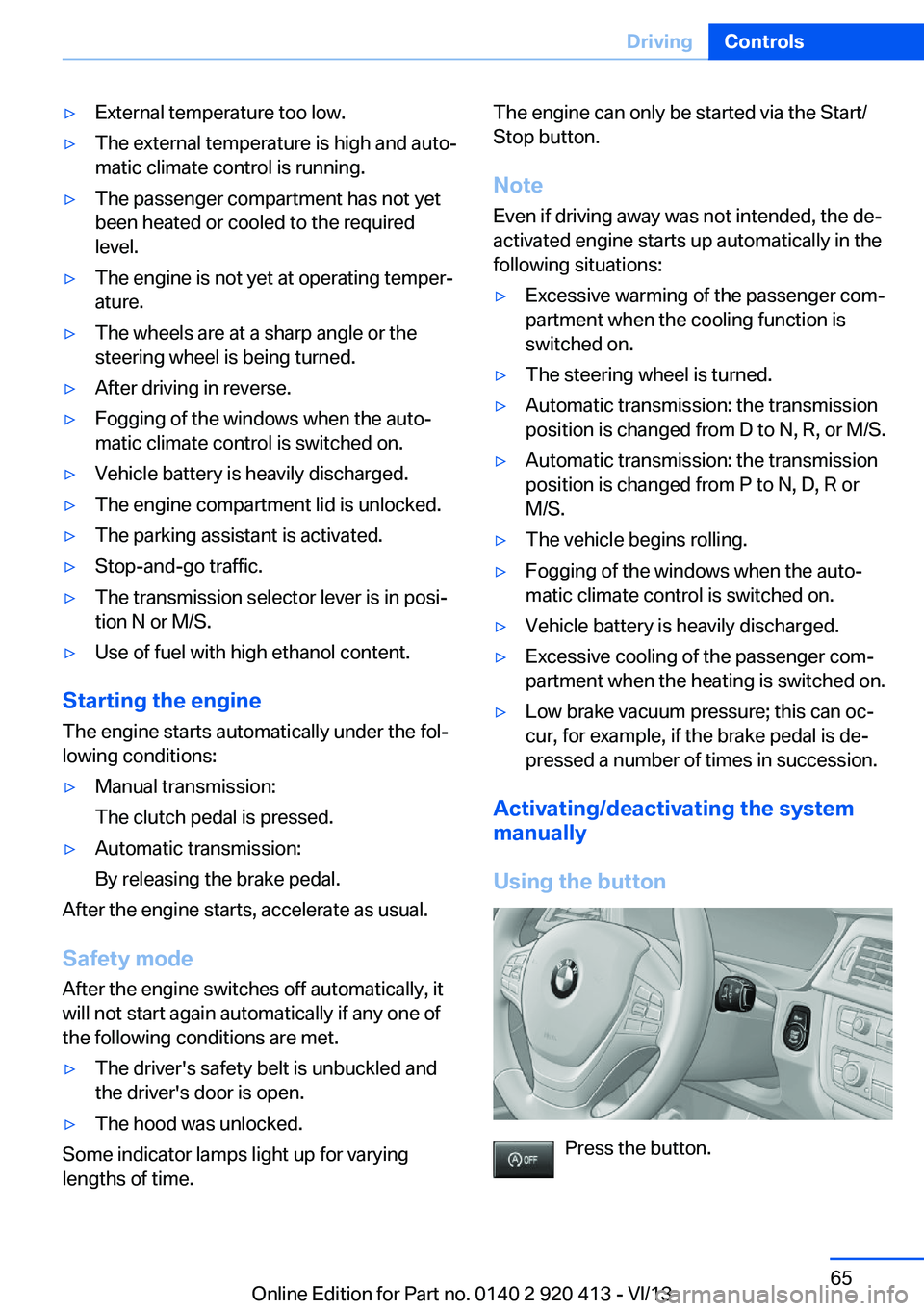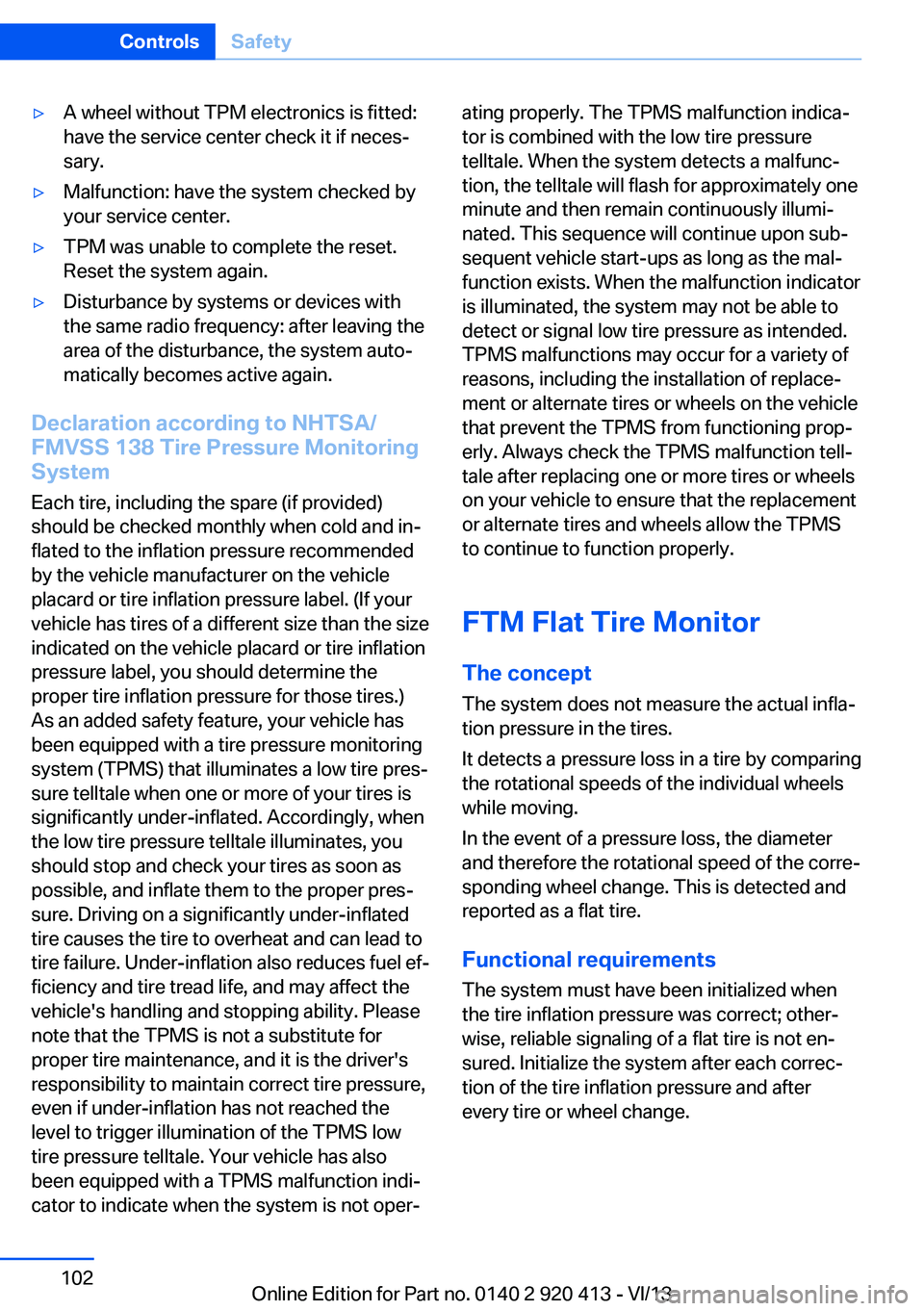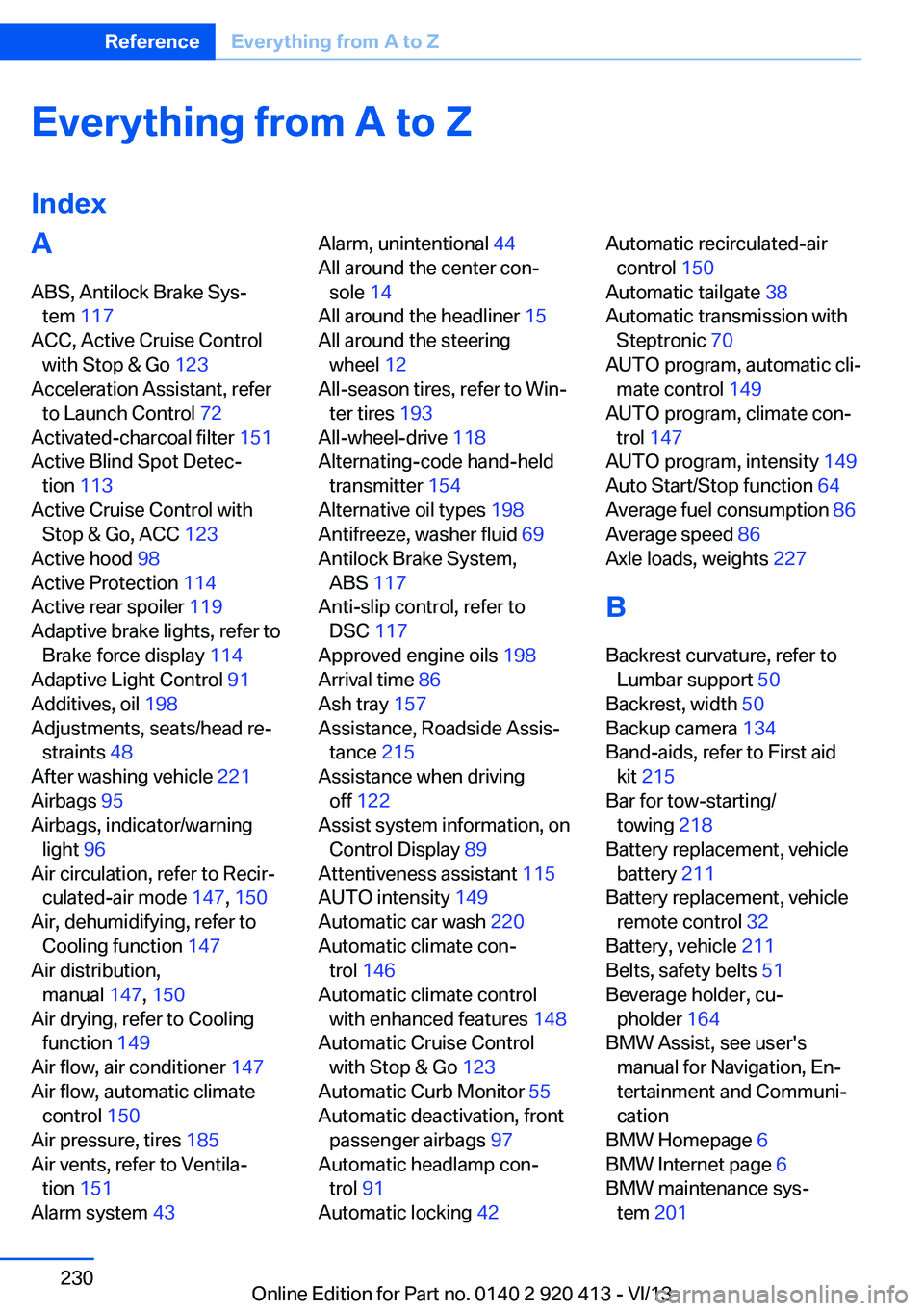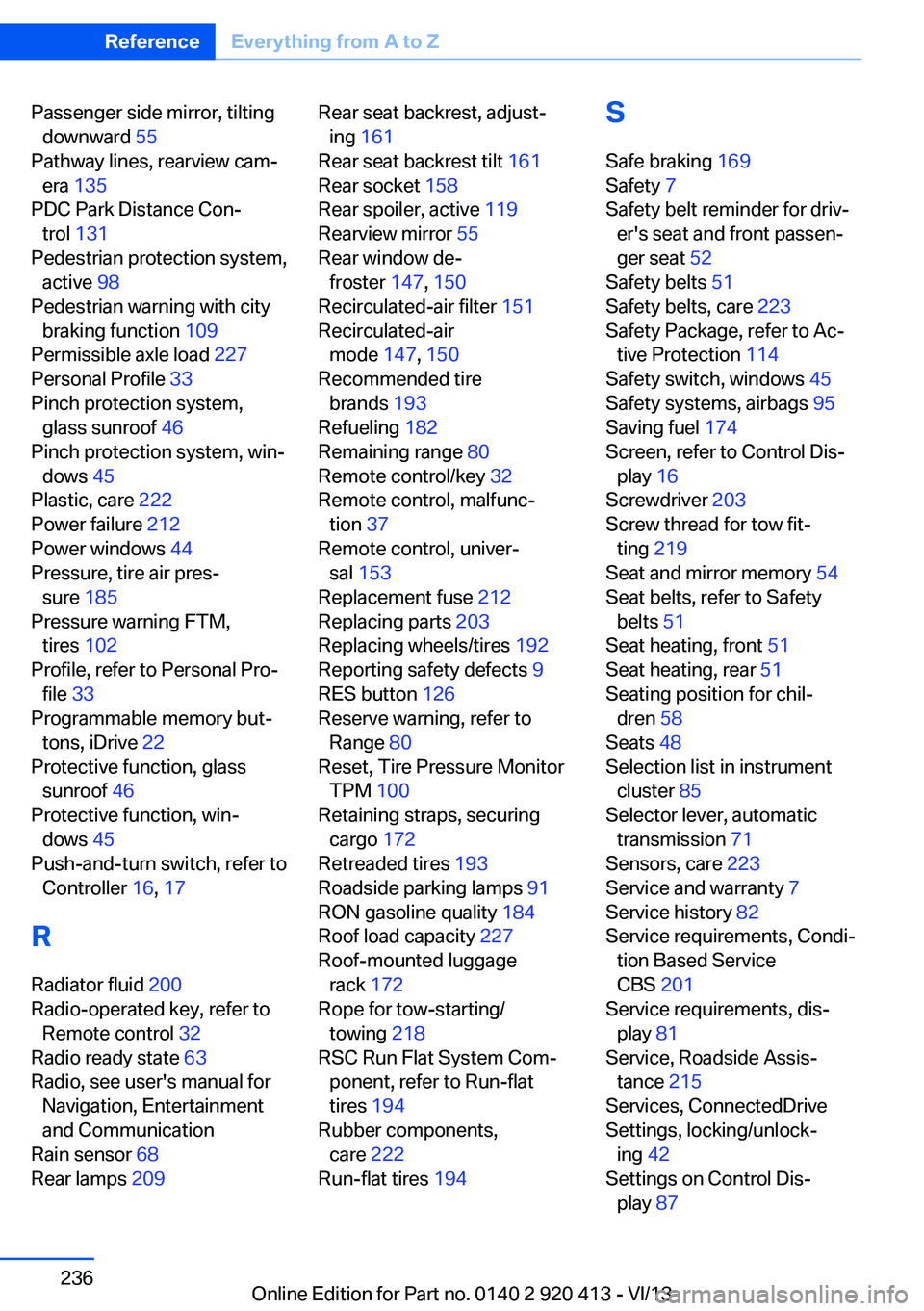fuel pressure BMW 335I XDRIVE GRAN TURISMO 2014 Owners Manual
[x] Cancel search | Manufacturer: BMW, Model Year: 2014, Model line: 335I XDRIVE GRAN TURISMO, Model: BMW 335I XDRIVE GRAN TURISMO 2014Pages: 240, PDF Size: 5.71 MB
Page 65 of 240

▷External temperature too low.▷The external temperature is high and auto‐
matic climate control is running.▷The passenger compartment has not yet
been heated or cooled to the required
level.▷The engine is not yet at operating temper‐
ature.▷The wheels are at a sharp angle or the
steering wheel is being turned.▷After driving in reverse.▷Fogging of the windows when the auto‐
matic climate control is switched on.▷Vehicle battery is heavily discharged.▷The engine compartment lid is unlocked.▷The parking assistant is activated.▷Stop-and-go traffic.▷The transmission selector lever is in posi‐
tion N or M/S.▷Use of fuel with high ethanol content.
Starting the engine
The engine starts automatically under the fol‐
lowing conditions:
▷Manual transmission:
The clutch pedal is pressed.▷Automatic transmission:
By releasing the brake pedal.
After the engine starts, accelerate as usual.
Safety mode
After the engine switches off automatically, it
will not start again automatically if any one of
the following conditions are met.
▷The driver's safety belt is unbuckled and
the driver's door is open.▷The hood was unlocked.
Some indicator lamps light up for varying
lengths of time.
The engine can only be started via the Start/
Stop button.
Note Even if driving away was not intended, the de‐
activated engine starts up automatically in the
following situations:▷Excessive warming of the passenger com‐
partment when the cooling function is
switched on.▷The steering wheel is turned.▷Automatic transmission: the transmission
position is changed from D to N, R, or M/S.▷Automatic transmission: the transmission
position is changed from P to N, D, R or
M/S.▷The vehicle begins rolling.▷Fogging of the windows when the auto‐
matic climate control is switched on.▷Vehicle battery is heavily discharged.▷Excessive cooling of the passenger com‐
partment when the heating is switched on.▷Low brake vacuum pressure; this can oc‐
cur, for example, if the brake pedal is de‐
pressed a number of times in succession.
Activating/deactivating the system
manually
Using the button
Press the button.
Seite 65DrivingControls65
Online Edition for Part no. 0140 2 920 413 - VI/13
Page 102 of 240

▷A wheel without TPM electronics is fitted:
have the service center check it if neces‐
sary.▷Malfunction: have the system checked by
your service center.▷TPM was unable to complete the reset.
Reset the system again.▷Disturbance by systems or devices with
the same radio frequency: after leaving the
area of the disturbance, the system auto‐
matically becomes active again.
Declaration according to NHTSA/
FMVSS 138 Tire Pressure Monitoring
System
Each tire, including the spare (if provided)
should be checked monthly when cold and in‐
flated to the inflation pressure recommended
by the vehicle manufacturer on the vehicle
placard or tire inflation pressure label. (If your
vehicle has tires of a different size than the size
indicated on the vehicle placard or tire inflation
pressure label, you should determine the
proper tire inflation pressure for those tires.)
As an added safety feature, your vehicle has
been equipped with a tire pressure monitoring
system (TPMS) that illuminates a low tire pres‐
sure telltale when one or more of your tires is
significantly under-inflated. Accordingly, when
the low tire pressure telltale illuminates, you
should stop and check your tires as soon as
possible, and inflate them to the proper pres‐
sure. Driving on a significantly under-inflated
tire causes the tire to overheat and can lead to
tire failure. Under-inflation also reduces fuel ef‐
ficiency and tire tread life, and may affect the
vehicle's handling and stopping ability. Please
note that the TPMS is not a substitute for
proper tire maintenance, and it is the driver's
responsibility to maintain correct tire pressure,
even if under-inflation has not reached the
level to trigger illumination of the TPMS low
tire pressure telltale. Your vehicle has also
been equipped with a TPMS malfunction indi‐
cator to indicate when the system is not oper‐
ating properly. The TPMS malfunction indica‐
tor is combined with the low tire pressure
telltale. When the system detects a malfunc‐
tion, the telltale will flash for approximately one
minute and then remain continuously illumi‐
nated. This sequence will continue upon sub‐
sequent vehicle start-ups as long as the mal‐
function exists. When the malfunction indicator
is illuminated, the system may not be able to
detect or signal low tire pressure as intended.
TPMS malfunctions may occur for a variety of
reasons, including the installation of replace‐
ment or alternate tires or wheels on the vehicle
that prevent the TPMS from functioning prop‐
erly. Always check the TPMS malfunction tell‐
tale after replacing one or more tires or wheels
on your vehicle to ensure that the replacement
or alternate tires and wheels allow the TPMS
to continue to function properly.
FTM Flat Tire Monitor
The concept The system does not measure the actual infla‐
tion pressure in the tires.
It detects a pressure loss in a tire by comparing
the rotational speeds of the individual wheels
while moving.
In the event of a pressure loss, the diameter
and therefore the rotational speed of the corre‐
sponding wheel change. This is detected and
reported as a flat tire.
Functional requirements
The system must have been initialized when
the tire inflation pressure was correct; other‐
wise, reliable signaling of a flat tire is not en‐
sured. Initialize the system after each correc‐ tion of the tire inflation pressure and afterevery tire or wheel change.Seite 102ControlsSafety102
Online Edition for Part no. 0140 2 920 413 - VI/13
Page 174 of 240

Saving fuelVehicle equipmentAll standard, country-specific and optional
equipment that is offered in the model series is
described in this chapter. Therefore, equip‐
ment is also described that is not available in a
vehicle, e. g., because of the selected optional
equipment or country variant. This also applies
for safety-related functions and systems.
General information Your vehicle contains advanced technology for
the reduction of fuel consumption and emis‐
sions.
Fuel consumption depends on a number of dif‐
ferent factors.
The implementation of certain measures, driv‐
ing style and regular maintenance can have an
influence on fuel consumption and on the envi‐
ronmental impact.
Remove unnecessary cargoAdditional weight increases fuel consumption.
Remove attached parts
following use
Remove auxiliary mirrors, roof or rear luggage
racks which are no longer required following
use.
Attached parts on the vehicle impair the aero‐
dynamics and increase the fuel consumption.Close the windows and glass
sunroof
Driving with the glass sunroof and windows
open results in increased air resistance and
raises fuel consumption.
Tires General information
Tires can affect fuel consumption values in
various ways, for instance fuel consumption
can be influenced by the size of the tires.
Check the tire inflation pressure
regularly
Check and, if necessary, correct the tire infla‐
tion pressure at least twice a month and before
starting on a long trip.
Low tire inflation pressure increases rolling re‐
sistance and thus raises fuel consumption and
tire wear.
Drive away without delay Do not wait for the engine to warm-up while
the vehicle remains stationary. Start driving
right away, but at moderate engine speeds.
This is the fastest way for the cold engine to
reach its operating temperature.
Look well ahead when
driving
Avoid unnecessary acceleration and braking.
By maintaining a suitable distance to the vehi‐
cle driving ahead of you.
Driving smoothly and looking ahead reduces
fuel consumption.Seite 174Driving tipsSaving fuel174
Online Edition for Part no. 0140 2 920 413 - VI/13
Page 194 of 240

Always protect tires against all contact with oil,
grease and fuels.
Do not exceed the maximum tire inflation pres‐
sure indicated on the side wall of the tire.
Run-flat tires
Label
RSC label on the tire sidewall.
The wheels are composed of special rims and
tires that are self-supporting, to a limited de‐
gree.
The support of the sidewall allows the tire to
remain drivable to a restricted degree in the
event of a pressure loss.
Continued driving with a damaged tire, refer to
page 104.
Continued driving with a damaged tire, refer to
page 101.
Changing run-flat tires
For your own safety, only use run-flat tires. No
spare tire is available in the case of a flat tire.
Your service center will be glad to advise you.
Snow chains
Fine-link snow chains
Only certain types of fine-link snow chains
have been tested by the manufacturer of your
vehicle, classified as road-safe and recom‐
mended.
Consult your service center for more informa‐
tion.
Use Use only in pairs on the rear wheels, equipped
with the tires of the following size:▷205/60 R 16.▷225/55 R 16.▷225/50 R 17.▷225/45 R 18.
Follow the chain manufacturer's instructions.
Make sure that the snow chains are always
sufficiently tight. Retighten as needed accord‐
ing to the chain manufacturer's instructions.
Do not initialize the Flat Tire Monitor after
mounting snow chains, as doing so may result
in incorrect readings.
Do not initialize the Tire Pressure Monitor after
mounting snow chains, as doing so may result
in incorrect readings.
When driving with snow chains, briefly activate
Dynamic Traction Control if necessary.
Maximum speed with snow chains Do not exceed a speed of 30 mph/50 km/h
when using snow chains.
Seite 194MobilityWheels and tires194
Online Edition for Part no. 0140 2 920 413 - VI/13
Page 230 of 240

Everything from A to Z
IndexA ABS, Antilock Brake Sys‐ tem 117
ACC, Active Cruise Control with Stop & Go 123
Acceleration Assistant, refer to Launch Control 72
Activated-charcoal filter 151
Active Blind Spot Detec‐ tion 113
Active Cruise Control with Stop & Go, ACC 123
Active hood 98
Active Protection 114
Active rear spoiler 119
Adaptive brake lights, refer to Brake force display 114
Adaptive Light Control 91
Additives, oil 198
Adjustments, seats/head re‐ straints 48
After washing vehicle 221
Airbags 95
Airbags, indicator/warning light 96
Air circulation, refer to Recir‐ culated-air mode 147, 150
Air, dehumidifying, refer to Cooling function 147
Air distribution, manual 147, 150
Air drying, refer to Cooling function 149
Air flow, air conditioner 147
Air flow, automatic climate control 150
Air pressure, tires 185
Air vents, refer to Ventila‐ tion 151
Alarm system 43 Alarm, unintentional 44
All around the center con‐ sole 14
All around the headliner 15
All around the steering wheel 12
All-season tires, refer to Win‐ ter tires 193
All-wheel-drive 118
Alternating-code hand-held transmitter 154
Alternative oil types 198
Antifreeze, washer fluid 69
Antilock Brake System, ABS 117
Anti-slip control, refer to DSC 117
Approved engine oils 198
Arrival time 86
Ash tray 157
Assistance, Roadside Assis‐ tance 215
Assistance when driving off 122
Assist system information, on Control Display 89
Attentiveness assistant 115
AUTO intensity 149
Automatic car wash 220
Automatic climate con‐ trol 146
Automatic climate control with enhanced features 148
Automatic Cruise Control with Stop & Go 123
Automatic Curb Monitor 55
Automatic deactivation, front passenger airbags 97
Automatic headlamp con‐ trol 91
Automatic locking 42 Automatic recirculated-air
control 150
Automatic tailgate 38
Automatic transmission with Steptronic 70
AUTO program, automatic cli‐ mate control 149
AUTO program, climate con‐ trol 147
AUTO program, intensity 149
Auto Start/Stop function 64
Average fuel consumption 86
Average speed 86
Axle loads, weights 227
B Backrest curvature, refer to Lumbar support 50
Backrest, width 50
Backup camera 134
Band-aids, refer to First aid kit 215
Bar for tow-starting/ towing 218
Battery replacement, vehicle battery 211
Battery replacement, vehicle remote control 32
Battery, vehicle 211
Belts, safety belts 51
Beverage holder, cu‐ pholder 164
BMW Assist, see user's manual for Navigation, En‐
tertainment and Communi‐
cation
BMW Homepage 6
BMW Internet page 6
BMW maintenance sys‐ tem 201 Seite 230ReferenceEverything from A to Z230
Online Edition for Part no. 0140 2 920 413 - VI/13
Page 233 of 240

Engine oil types, ap‐proved 198
Engine start during malfunc‐ tion 33
Engine start, jump-start‐ ing 215
Engine start, refer to Starting the engine 63
Engine stop 63
Engine temperature 79
Entering a car wash 220
Equipment, interior 153
ESP Electronic Stability Pro‐ gram, refer to DSC 117
Exchanging wheels/tires 192
Exhaust system 169
Exterior mirror, automatic dimming feature 56
Exterior mirrors 55
External start 215
External temperature dis‐ play 80
External temperature warn‐ ing 80
Eyes for securing cargo 172
F
Failure message, refer to Check Control 77
False alarm, refer to Uninten‐ tional alarm 44
Fan, refer to Air flow 147, 150
Fault displays, refer to Check Control 77
Filler neck for engine oil 198
Fine wood, care 222
First aid kit 215
Fitting for towing, refer to Tow fitting 218
Flat tire, changing wheels 211
Flat Tire Monitor FTM 102
Flat tire, Tire Pressure Moni‐ tor TPM 99 Flat tire, warning
lamp 100, 103
Flooding 169
Floor carpet, care 223
Floor mats, care 223
Fogged up windows 147
Fold-out position, windshield wipers 69
Foot brake 169
Front airbags 95
Front fog lamps 93
Front fog lamps, front, bulb replacement 208
Front lamps 204
Front passenger airbags, au‐ tomatic deactivation 97
Front passenger airbags, indi‐ cator lamp 97
FTM Flat Tire Monitor 102
Fuel 184
Fuel cap 182
Fuel consumption, current 81
Fuel consumption, refer to Average fuel consump‐
tion 86
Fuel filler flap 182
Fuel gauge 79
Fuel quality 184
Fuel recommendation 184
Fuel, tank capacity 229
Fuse 212
G
Garage door opener, refer to Integrated universal remote
control 153
Gasoline 184
Gasoline quality 184
Gear change, automatic transmission 71
Gear shift indicator 82
General driving notes 168
Glass sunroof, refer to Panor‐ amic glass sunroof 45
Glove compartment 162 Gross vehicle weight, ap‐
proved 227
Gross weight, permissible for trailer towing 227
H
Handbrake, refer to parking brake 66
Hand-held transmitter, alter‐ nating code 154
Hazard warning flashers 214
Head airbags 95
Headlamp control, auto‐ matic 91
Headlamp courtesy delay fea‐ ture 90
Headlamp flasher 67
Headlamp glass 204
Headlamps 204
Headlamps, care 221
Headlamp washer system 67
Headliner 15
Head restraints 48
Head restraints, front 52
Head restraints, rear 53
Head-up Display 144
Head-up Display, care 223
Heavy cargo, stowing 172
Height, vehicle 226
High-beam Assistant 92
High beams 67
High beams/low beams, refer to High-beam Assistant 92
Hills 170
Hill start assistant, refer to Drive-off assistant 122
Hints 6
Holder for beverages 164
Homepage 6
Hood 196
Horn 12
Hot exhaust system 169
HUD Head-up Display 144
Hydroplaning 169 Seite 233Everything from A to ZReference233
Online Edition for Part no. 0140 2 920 413 - VI/13
Page 236 of 240

Passenger side mirror, tiltingdownward 55
Pathway lines, rearview cam‐ era 135
PDC Park Distance Con‐ trol 131
Pedestrian protection system, active 98
Pedestrian warning with city braking function 109
Permissible axle load 227
Personal Profile 33
Pinch protection system, glass sunroof 46
Pinch protection system, win‐ dows 45
Plastic, care 222
Power failure 212
Power windows 44
Pressure, tire air pres‐ sure 185
Pressure warning FTM, tires 102
Profile, refer to Personal Pro‐ file 33
Programmable memory but‐ tons, iDrive 22
Protective function, glass sunroof 46
Protective function, win‐ dows 45
Push-and-turn switch, refer to Controller 16, 17
R Radiator fluid 200
Radio-operated key, refer to Remote control 32
Radio ready state 63
Radio, see user's manual for Navigation, Entertainment
and Communication
Rain sensor 68
Rear lamps 209 Rear seat backrest, adjust‐
ing 161
Rear seat backrest tilt 161
Rear socket 158
Rear spoiler, active 119
Rearview mirror 55
Rear window de‐ froster 147, 150
Recirculated-air filter 151
Recirculated-air mode 147, 150
Recommended tire brands 193
Refueling 182
Remaining range 80
Remote control/key 32
Remote control, malfunc‐ tion 37
Remote control, univer‐ sal 153
Replacement fuse 212
Replacing parts 203
Replacing wheels/tires 192
Reporting safety defects 9
RES button 126
Reserve warning, refer to Range 80
Reset, Tire Pressure Monitor TPM 100
Retaining straps, securing cargo 172
Retreaded tires 193
Roadside parking lamps 91
RON gasoline quality 184
Roof load capacity 227
Roof-mounted luggage rack 172
Rope for tow-starting/ towing 218
RSC Run Flat System Com‐ ponent, refer to Run-flat
tires 194
Rubber components, care 222
Run-flat tires 194 S
Safe braking 169
Safety 7
Safety belt reminder for driv‐ er's seat and front passen‐
ger seat 52
Safety belts 51
Safety belts, care 223
Safety Package, refer to Ac‐ tive Protection 114
Safety switch, windows 45
Safety systems, airbags 95
Saving fuel 174
Screen, refer to Control Dis‐ play 16
Screwdriver 203
Screw thread for tow fit‐ ting 219
Seat and mirror memory 54
Seat belts, refer to Safety belts 51
Seat heating, front 51
Seat heating, rear 51
Seating position for chil‐ dren 58
Seats 48
Selection list in instrument cluster 85
Selector lever, automatic transmission 71
Sensors, care 223
Service and warranty 7
Service history 82
Service requirements, Condi‐ tion Based Service
CBS 201
Service requirements, dis‐ play 81
Service, Roadside Assis‐ tance 215
Services, ConnectedDrive
Settings, locking/unlock‐ ing 42
Settings on Control Dis‐ play 87 Seite 236ReferenceEverything from A to Z236
Online Edition for Part no. 0140 2 920 413 - VI/13